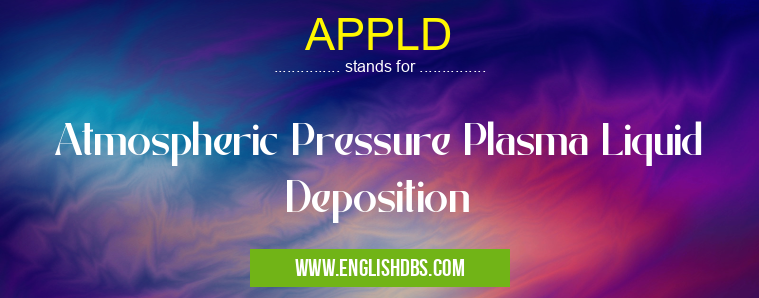What does APPLD mean in ATMOSPHERE
Atmospheric pressure plasma liquid deposition (APPLD) is a process in which a plasma jet is used for treating liquid surfaces. It has become a common technique among the materials engineers due to its ability to produce enhanced surfaces with improved properties. APPLD technology involves the deposition of thin films on both solid and liquid substrates by using low-temperature, non-thermal plasma processes. This technology enables the fabrication of highly ordered nanostructured materials with unique surface morphologies, complex topography, and superior physical and chemical properties. The advantages of APPLD include faster process speeds, uniformity over large areas, and cost savings due to the easy manufacturing process setup. Additionally, this technology offers an environmentally friendly alternative to conventional wet etching and dry cleaning methods.

APPLD meaning in Atmosphere in Academic & Science
APPLD mostly used in an acronym Atmosphere in Category Academic & Science that means Atmospheric Pressure Plasma Liquid Deposition
Shorthand: APPLD,
Full Form: Atmospheric Pressure Plasma Liquid Deposition
For more information of "Atmospheric Pressure Plasma Liquid Deposition", see the section below.
Overview of APPLD
Atmospheric pressure plasma liquid deposition (APPLD) is a technique that combines the advantages of atmospheric pressure plasmas with those of traditional wet chemistry solutions to provide a versatile tool for producing nanostructured surfaces with improved properties. Gas phase plasmas are generated at atmospheric pressure from precursor gases such as oxygen, helium or nitrogen gas containing specific reactive species. These active species interact with liquids during the etching process at room temperature, resulting in enhanced surface characteristics such as homogeneity, densification or adhesion improvement. Due to its versatility and environmental friendly nature, this technology has been widely utilized in a variety of fields including biomedical engineering, electronic materials, thin film fabrication and even surface modification of textiles.
Advantages of APPLD
One major advantage offered by Atmosphere Pressure Plasma Liquid Deposition (APPLD) is its ability to produce nanostructured surfaces that have superior physical and chemical properties when compared to traditional wet chemistry solutions or dry cleaning techniques. Moreover, this technology also offers high speed processing times while maintaining uniformity over large areas. Additionally, it provides an efficient manufacturing process setup that yields cost savings compared to other manufacturing methods such as wet etching or thermal treatments that require higher temperatures and greater energy input for processing. Furthermore, this technology utilizes precursor gases containing reactive species that can interact with liquids during room temperature processing enabling better control over surface parameters such as homogeneity density or adhesion improvement that would otherwise be difficult to achieve using other processes like thermally activated reactions or chemical vapor deposition . Finally, by utilizing non-thermal plasmas at atmospheric pressure it provides an environmentally friendly alternative method for producing nanostructured materials.
Essential Questions and Answers on Atmospheric Pressure Plasma Liquid Deposition in "SCIENCE»ATMOSPHERE"
What is Atmospheric Pressure Plasma Liquid Deposition (APPLD)?
Atmospheric Plasma-Liquid Deposition (APPLD) is a novel technique that combines the power of atmospheric pressure plasmas with liquid chemistry. It utilizes the aerosolization and deposition of aqueous droplets in an ambient air plasma to form thin layers of materials on various surfaces. APPLD combines the advantages of liquid deposition, such as simplicity, flexibility, low cost and scalability with those offered by the dry plasmas, including high deposition rates and excellent surface properties.
What are the benefits of using APPLD?
The main benefit of using APPLD is its efficiency in producing conformal coating without losing its superior surface properties. Compared to traditional methods for depositing thin layers onto solid surfaces, APPLD reduces substrate preparation time and process costs significantly while it yields smoother substrates with higher coverage rates. Moreover, APPLD offers compatibility with multiple materials including ceramic substrates or conformal coatings for electronics components.
How does APPLD works?
Atmosphere Plasma-Liquid Deposition (APPLD) relies on two steps for thin layer formation. First, a liquid is aerosolized by an atmospheric pressure plasma jet composed mainly by nitrogen flow; then upon impingement on the target substrate surface, droplets condense due to their cooling effect and form a film or coating. Finally, as ions from the plasma jet impact on the spreading droplet film some chemical transformations occur which lead to material modification if desired or necessary.
What are the applications of APPLD technology?
This advanced technology has been used in many industrial fields such as corrosion protection for metals including aluminum and steel alloys, ultra-hard coatings for tools cutting edges as well as anti-sticking films for food processing lines. Furthermore, APPLD can be used in medical applications like wound healing treatments due to its ability to produce antimicrobial layers that promote cell growth.
Is there any limitation when using APPLD?
Yes, although this technique shows great potential in terms of scalability and flexibility compared to other techniques such as physical vapor deposition it still presents certain limitations related to material characteristics such as their low volatility or high boiling point temperatures which negatively affects performance.
Does this technique require additional specialised equipment?
Not necessarily - depending upon its intended use a standard plasma system can be employed but if more complex processes such as controlling gas mixtures are required then specific instruments need to be integrated into the lab setup.
Final Words:
Atmospheric Pressure Plasma Liquid Deposition (APPLD) is an efficient technology offering numerous advantages including faster processing times due to reduced energy input requirement along with cost savings associated with simplifying manufacturing process setup requirements without sacrificing quality assurance over large area substrates treated under this method With its ease in use coupled with versatility in achieving desired qualities in nano-structured products it has become one oft hem prefered choice among material engineers for creating various applications from textiles to flatscreen displays.
